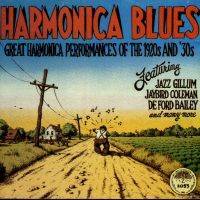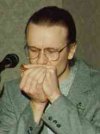 |
Train & Harmonica |
|
Harmonica, Blues and Locomotives...
by J.J. Milteau
Popular music has always used the social and technological
environment as a natural inspiration, but rarely have an instrument and a means of
transportation been as closely associated as train and harmonica in the first half of the
20th century in the United States. One could suggest that the specific
draw/blow structure of the harmonica, the possibility of ‘pulling’ on the 7/9
chord (2,3,4,5,6 draw), the throat, jaw, tongue and hand effects are all particularly
fitted to the evocation of the panting of a locomotive, the rythm of the wagons on the
rails and the faraway howl of the Panama Limited or the Wabash Cannonball.
Since the earliest harmonica recordings date from to the early 20s,
one can only imagine the origins of this imitation tradition that probably goes back to
the 19th century, the bronze age of both railroad and harmonica. The
latter’s vocation seems to have been the imitation of human voices (Mama Blues ...),
animal cries (Fox Chase ...), all part of a repertoire well-adapted to the
instrument’s great expressivity, but also aiming at drawing the attention of the
public of the traveling shows that criss-crossed the US at the time, as related by Peg Leg
Sam and Sonny Terry. The sound of an thundering express train emanating from such a tiny
instrument was somthing quite astonishing indeed ! Consequently, one may observe that
the harmonica was often recorded as a solo instrument in these early days and that the
repertoire had little relation to later classification of black = blues and white =
country music.
Let’s look at some of the landmark train imitations on the
harp :
|
How to play
Pan American Blues (tablatures and slowed down version) |
 "Pan American Blues"
by De Ford Bailey (1927) "Pan American Blues"
by De Ford Bailey (1927)
"Harmonica Blues 1927/1941" Fremeaux FA040 (A 1)This is, I believe the earliest such
piece recorded. De Ford Bailey would have been 100 years old in 1999. This frail and
unknown little man is an astounding revelation : in the late 20s he recorded several
famous harmonica pieces that give us a better idea of how the instrument was used in the
late 19th- early 20th century. Black and crippled he became a star
of the Grand Ole Opry, the temple of Country Music between 1925 et 1941 and participated
to many shows and radio programs before ending his life shining shoes. He often played on
G and A harps, both in first and second position, using few bends but lots of tongue
blocking. He used to declare : "I add time to vacant space". This character well
deserves an article unto himself since he had a considerable influence on many musicians
who saw him live or heard him on the radio.
Before we move on,
it’s interesting to mention that on certain old recordings that have been remastered,
the harmonica tone is approximate. On the CD "Great harp players 1927/1936"
Document DOCD-5100, Richard Sowell seems to be playing "John Henry" on a low F
sharp (quite rare) and "Roubin Blues" also. These are more likely to have been
harmonicas a semi-tone higher ie. G. Some of the pieces described below by George Bullet
Williams and Palmer Mc Abee may be affected by the same distorsion.
|
How to play
Frisco Leavin'
Birmingham
(tablatures and slowed down version) |
"Frisco leavin' Birmingham" by George Bullet
Williams (1928)
"Great harp players 1927/1936" Document DOCD-5100 (Ab 2)A brilliant demonstration of
‘sung’ harmonica, combining various shouts, notes and a confusing double
tonguing (the end of the piece is played both in the low and high registers !) The same
artist (in the same key) also interprets "The escaped convict" with of course
some reference to railroads.
|
How to play
McAbee's Railroad
Piece
(tablatures and slowed down version) |
"Mc Abee's Railroad Piece" by Palmer Mc Abee (1928)
"Great harp players 1927/1936" Document DOCD-5100 (Ab 2)Both sound and tempo are amazing,
enhanced by steam projections and astounding variations in intensity. According to obscure
sources, McAbee was a white artist. I gather he was rather the extra-terrestrial offspring
of a pneumatic drill !
|
How to play
Railroad Blues
(tablatures and slowed down version) |
 "Railroad Blues" by
Freeman Stowers (1929) "Railroad Blues" by
Freeman Stowers (1929)
"Harmonica Blues" Yazoo 1053 (Bb 1)Here also we find an association of notes and voice,
eased by the choice of 1st position and used to generate various effects. The
blow bends give a different feel to the steam moans.
"Chickasaw Special" by Noah Lewis (1929)
"Gus Cannon & Noah Lewis" Document DOCD-5033 (D 2)
The highest harp used in the
pieces overviewed here. It generates less resonance but allows a more lyrical and flexible
playing. Noah Lewis seems to have been a powerful harp player (a quality much valued in
these days of poor amplification) and an important link between the rural style of
expression and the Memphis Jug Bands. He also would deserve a more in-depth observation.
"Train Whistle Blues" by Sonny Terry (1938)
" Document DOCD-5230 qui deviendra "Locomotive Blues" (Bb 1)
A rare use of first position in
Sonny Terry’s works (along with Shortnin’ Bread ) which probably sounds closer
to the way his father played, a very different sound from the blues sound which he
discovered as a teenager.
"Lonesome Train" by Sonny Terry (1944)
Document DOCD-5230 (G 2)
Is more a modified version of his
"Lost John" than a genuine train imitation, but it’s always so exciting to
hear Sonny alternate whoops and the unique rhythms he obtains by combining throat, tongue,
jaw and hand effects…
"Freight Train" by Dr Ross (1965)
"Call the Doctor" Testament TCD5009 (Bb 2)
This CD is a treat for any
"Delta Blues" fans. On several track the doctor abandons his guitar and bass
drum and plays some tasteful solo harmonica pieces in the rural pre-war style of
Tennessee, the sound of Hammie Nixon, John Lee Williamson, Noah Lewis and De Ford Bailey.
"New Mean Old Train" by Papa George Lightfoot (1969)
"Goin' Back to the Natchez Trace" Ace CDCHD 548 (G 2)
Let’s say it straight, this
isn’t the best stuff that Papa Lightfoot ever played : the phrasing is conventional
and the rhythm strange (the caisse claire (?) insists on marking the 1st and 3rd
beats ! It has the merit nonetheless of being one of the rare available examples of the
power and fullness of this interesting Mississippi harp player who was extremely popular
in New Orleans in the early 50's. On this same CD we find an equally messy "Train
Tune" with an intro inspired by Duke Ellington’s C jam Blues, a reference to
Lightfoot’s horn influences.
"Fast Freight Train" by Peg Leg Sam (1972)
"Medicine Show Man" Trix 3302 (C 2)
A more country tempo and a guitar
accompaniment make this comparatively recent piece an unusual one. It is based in
tradition nonetheless : a succession of shouts, breathing, rythms and various noises. Peg
Leg Sam who lost his leg in a train accident knew what he was talking about ! One of the
last survivors of Medecine Shows, he plays in a rural vein with a very pleasant sound and
a groove that’s only his own.
Progressively, the automobile replaces the train in the blues
imagery, but the train will remain as a symbol of the romantic ‘hobo’ or an
evocation of departure. In many titles it is closer to evocation that imitation. A few
examples are :
"Freight Train Blues" by
Roy Acuff with Jimmie Riddle on chromatic (Columbia in 1947)
"Mystery Train" by Paul
Butterfield (A 2) ; an interesting version on a 1967 live bootleg (Winner 446).
"All Aboard" by Muddy
Waters, with P. Butterfield (Marine Band G 2) and Jeff Carp (Chrom C 3) "Fathers
& Sons" Chess CD Red 8 (1969)
"Orange Blossom Special" by
Charlie Mc Coy ; my favourite version is one of the early ones (1972), cool and swinging
on the "Real Mc Coy" album (F2 & Bb2 + bass harmonica).
As a conclusion, it’s
worth mentioning that the famous hit by Little Walter and Willie Dixon "My Babe"
is closely inspired by the gospel song "This Train"... Trains everywhere !
|
|
|
 Jean-Jacques
Milteau Jean-Jacques
Milteau
Well know French harp player (see the interview in PH1), JJ's first love was pre-war harp
players. He agreed to do some research in train imitations and write the above overview.
He also agreed, with all the due respect, to record the slowed down versions of some of
the train patterns. He himself describes these slow mos as imperfect. 'It's hard to
imitate in five minutes the groove of a lifetime' he says. 'Use the originals as
inspiration, don't just imitate them' he adds.
It's worth mentioning that JJ dies a storming train imitation of his own on his 'Blues
Live' album under the title 'Lonesome Train'. |
 Joe Filisko Joe Filisko
Exceptional US harp player and technician, Joe teaches Chicago harp in Chicago. But his
true calling lies in pre-war harp styles.
He agreed to do transcriptions of four of the landmark train imitations for us.
He teaches each monday night at the Old Town School of Folk Music (4544 N. Lincoln Avenue
/ 773.728.6000 or www.oldtownschool.org)
He will also be one of the professeurs for Blues Week at the Augusta Heritage Center next
July (for more info try 304.637.1209 or augusta@augustaheritage.com)
|
|
|
|